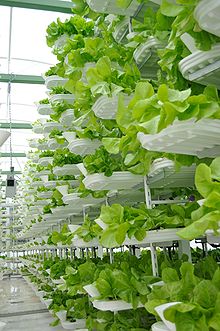
Back مزرعة رأسية Arabic উর্ধ্বাধ চাষ ব্যবস্থা Bengali/Bangla Vertikální zemědělství Czech Vertikale Landwirtschaft German Κάθετη γεωργία Greek Vertikala kultivado Esperanto Granja vertical Spanish Vertikaalaiandus Estonian کشاورزی عمودی Persian Kerrosviljely Finnish
The examples and perspective in this article may not represent a worldwide view of the subject. (July 2023) |

Vertical farming is the practice of growing crops in vertically stacked layers.[1] It often incorporates controlled-environment agriculture, which aims to optimize plant growth, and soilless farming techniques such as hydroponics, aquaponics, and aeroponics.[1] Some common choices of structures to house vertical farming systems include buildings, shipping containers, underground tunnels, and abandoned mine shafts.
The modern concept of vertical farming was proposed in 1999 by Dickson Despommier, professor of Public and Environmental Health at Columbia University.[2] Despommier and his students came up with a design of a skyscraper farm that could feed 50,000 people.[3] Although the design has not yet been built, it successfully popularized the idea of vertical farming.[3] Current applications of vertical farmings coupled with other state-of-the-art technologies, such as specialized LED lights, have resulted in over 10 times the crop yield than would receive through traditional farming methods.[4] There have been several different means of implementing vertical farming systems into communities such as: Paignton,[5] Israel,[6] Singapore,[7] Chicago,[8] Munich,[9] London,[10] Japan,[4] and Lincolnshire.[11]
The main advantage of utilizing vertical farming technologies is the increased crop yield that comes with a smaller unit area of land requirement.[12] The increased ability to cultivate a larger variety of crops at once because crops do not share the same plots of land while growing is another sought-after advantage. Additionally, crops are resistant to weather disruptions because of their placement indoors, meaning less crops lost to extreme or unexpected weather occurrences. Lastly, because of its limited land usage, vertical farming is less disruptive to the native plants and animals, leading to further conservation of the local flora and fauna.[13]
Vertical farming technologies face economic challenges with large start-up costs compared to traditional farms. They cannot grow all types of crops but can be cost-effective for high value products such as salad vegetables.[14] Vertical farms also face large energy demands due to the use of supplementary light like LEDs. The buildings also need excellent control of temperature, humidity and water supplies. Moreover, if non-renewable energy is used to meet these energy demands, vertical farms could produce more pollution than traditional farms or greenhouses.
- ^ a b Birkby, Jeff (January 2016). "Vertical Farming". ATTRA Sustainable Agriculture Program. Retrieved 28 October 2019.
- ^ "Dickson Despommier | Columbia University Mailman School of Public Health". www.mailman.columbia.edu. Retrieved 4 November 2019.
- ^ a b Cooper, Arnie (14 June 2017). "Going Up? Vertical Farming in High-Rises Raises Hopes". Pacific Standard. Retrieved 4 November 2019.
- ^ a b Benke, Kurt; Tomkins, Bruce (1 January 2017). "Future food-production systems: vertical farming and controlled-environment agriculture". Sustainability: Science, Practice and Policy. 13 (1): 13–26. Bibcode:2017SSPP...13...13B. doi:10.1080/15487733.2017.1394054.
- ^ Fredani, Kevin (June 2010). "Vertical Plant Production as a Public Exhibit at Paignton Zoo" (PDF). Proceedings Pf the 4th Global Botanic Gardens Congress.
- ^ "Green Zionist Alliance (GZA) - Bold Resolutions for 36th World Zionist Congress". Green Prophet | Impact News for the Middle East. 1 June 2010. Retrieved 8 November 2019.
- ^ "First commercial vertical farm opens in Singapore - Channel NewsAsia". 27 October 2012. Archived from the original on 27 October 2012. Retrieved 8 November 2019.
- ^ Meghna (20 June 2017). "Vertical Farms in Cities are the Future of Urban Farming". Evolving Science. Retrieved 8 November 2019.
- ^ "AGRITECTURE - Vertical Farming Technology Trends". 11 June 2015. Archived from the original on 11 June 2015. Retrieved 8 November 2019.
- ^ Grossman, David (3 December 2018). "Abandoned Coal Mines Could Be Future of Farming". Popular Mechanics. Retrieved 8 November 2019.
- ^ "The Future of Farming: Robots, Bees and Vertical Farms". AGRITECTURE. Retrieved 8 November 2019.
- ^ "Indoor farming and outdoor farming average yield per acre worldwide 2015". Statista. Retrieved 7 November 2019.
- ^ Navarro, Laetitia M.; Pereira, Henrique M. (1 September 2012). "Rewilding Abandoned Landscapes in Europe". Ecosystems. 15 (6): 900–912. Bibcode:2012Ecosy..15..900N. doi:10.1007/s10021-012-9558-7. ISSN 1435-0629.
- ^ Harvey, Dave (20 February 2024). "Gloucestershire vertical farm is one of UK's 'most advanced'". BBC News. Retrieved 22 February 2024.
© MMXXIII Rich X Search. We shall prevail. All rights reserved. Rich X Search